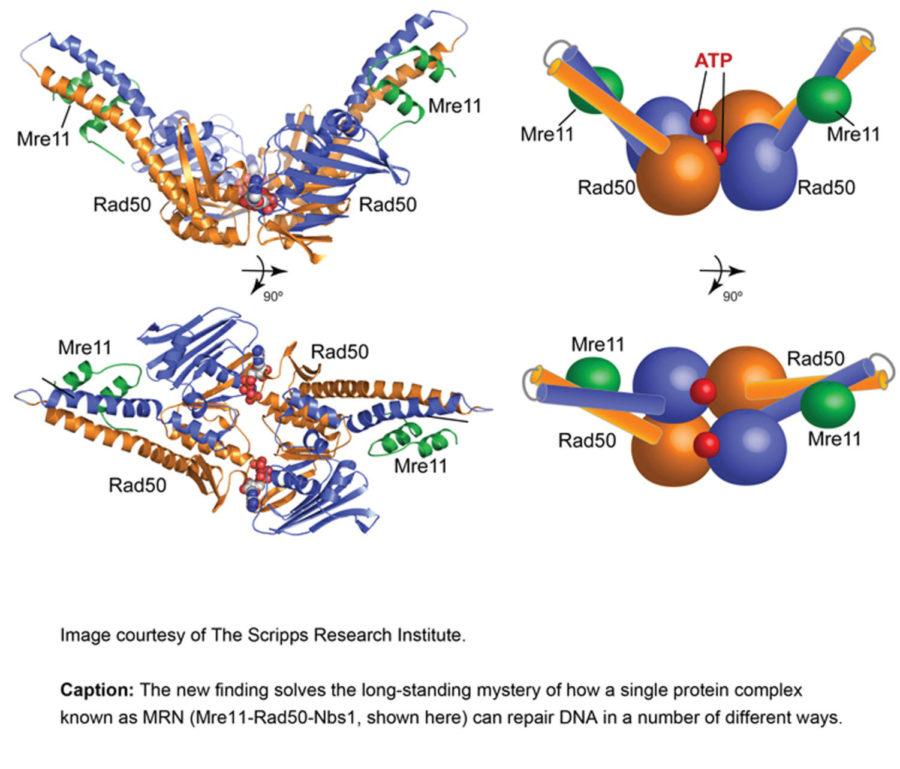Research helps understand repair of DNA
The protein, named Mre11/Rad50, found in many organisms, such as viruses in addition to plants and animals, is used to repair DNA structure breaks. Scott Nelson heads the investigation to find the enzyme to repair DNA.
September 30, 2012
Progressive research on an important protein which repairs DNA is under way at Iowa State. Scott Nelson, assistant professor of biochemistry, biophysics and molecular biology, heads the investigation to find this vital enzyme with the promise to repair DNA, sponsored with the help of a grant from the National Science Foundation.
The protein, named Mre11/Rad50, found in many organisms, such as viruses in addition to plants and animals, is used to repair DNA after the DNA structure breaks. Nelson and his team are not studying the protein to be used for direct medical applications, but said the information found in the molecular structure can benefit many areas of science.
“We’re mainly focusing on fundamental understanding on how the protein works on the molecular level, which can be used to identify regions of the protein which might be good sites for design of a drug, but we’re not at that stage,” Nelson said. “Pharmaceutical companies might use the research to help design the drugs.”
Nelson has been collaborating with researchers at Duke University Medical School and St. Jude Children’s Research Hospital. The investigators from Duke take mutations in organisms from Nelson’s lab to study how they affect how the repair proteins behave. The research also examines the effect the mutations have on organisms and their ability to repair their DNA.
“It’s a big fundamental question: how organisms maintain their genetic material in the face of all these DNA damaging agents we’re exposed to on a daily basis,” Nelson said. “Knowing how the body does that, we can maybe start to understand what’s happening when mistakes are made.”
A desire to work on a complex system drives Nelson’s research. DNA replication is very complex and essential to the biology of every organism. Nelson began his study on DNA replication at Penn State and returned to Iowa State three years ago as an independent scientist.
Assisting Nelson in the research project is Tasida Barfoot, graduate student in biochemistry, biophysics and molecular biology.
“I do research on this project every day,” Barfoot said. “This work is interesting. It also requires dedication and patience — there is never one ‘Eureka!’ moment. Instead, our understanding of how the [DNA repairing protein] complex works is built slowly, one experiment at a time.”
The research Nelson and Barfoot study is essential to understanding how to repair DNA structures, especially when modern medicine sometimes breaks down DNA structures for cancer treatments.
“Many cancer drugs, the mechanism of cancer treatment, say X-ray or chemo therapies, cause a lot of double strand breaks in the tumor cells. So many DNA breaks that the tumor cell dies,” Nelson said. “Tumor cells can sometimes resist those treatments by up regulating their DNA repair pathways.”
Although this research does not directly search for the cure for cancer, the study may provide essential information for more understanding of how the DNA protein works. Ideally, the knowledge in the lab today could turn into more effective cancer treatments in the future.
“The protein complex we work on is a target for drug design with the idea that if you can inhibit the proteins in the tumor cell,” Nelson said. “It would then prevent them from repairing their DNA which has been damaged by the [cancer] treatments, making current treatments more effective.”







